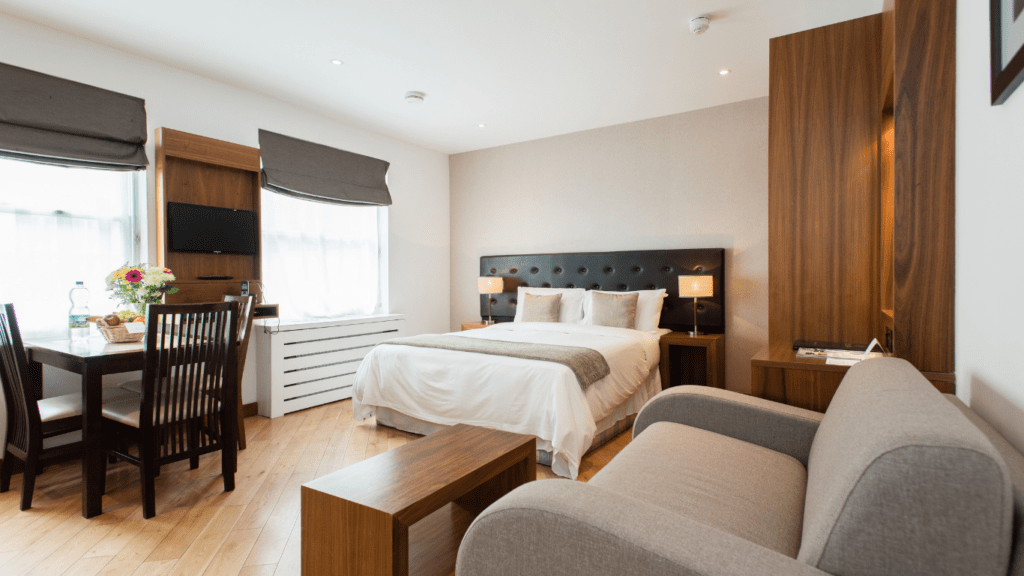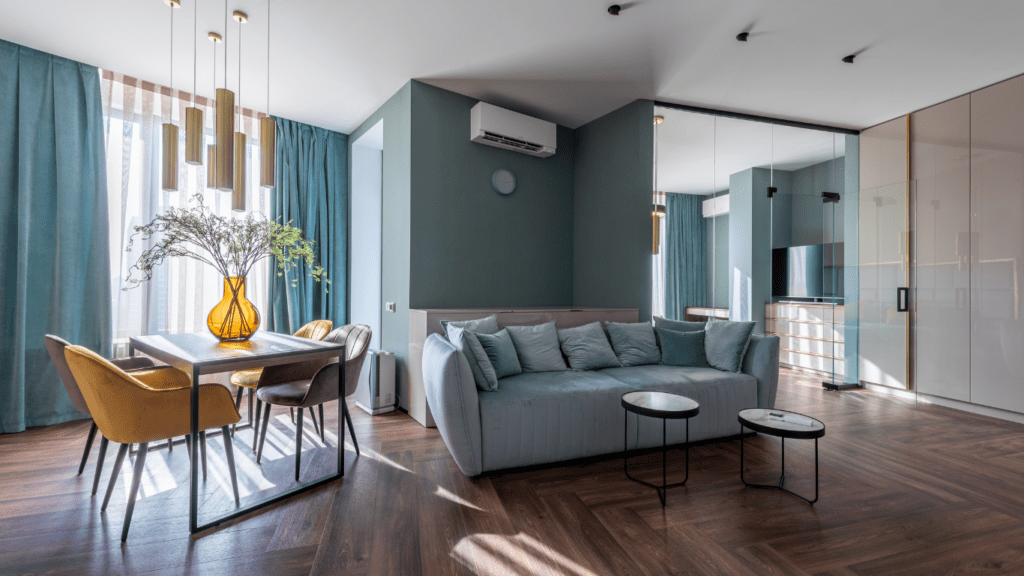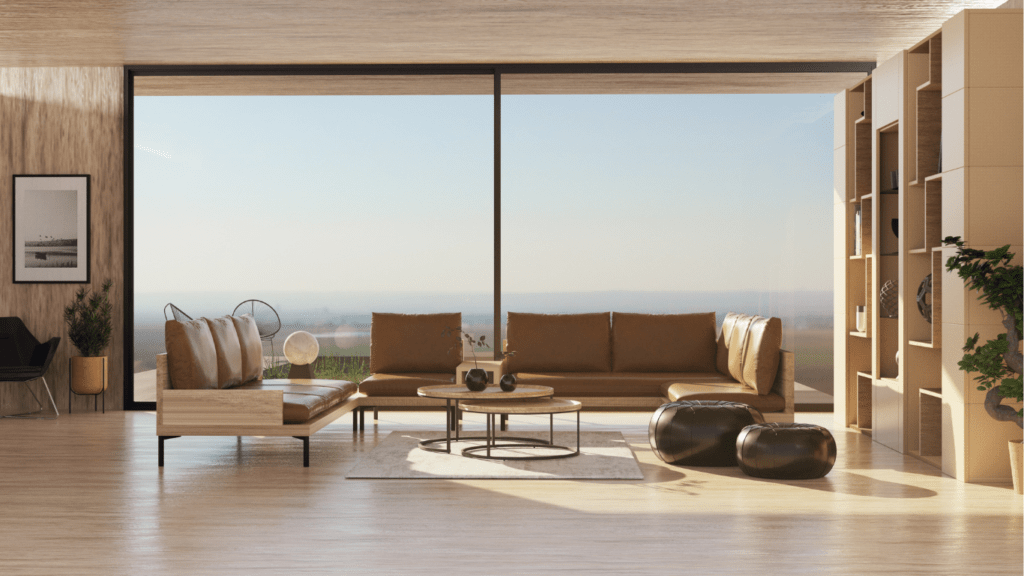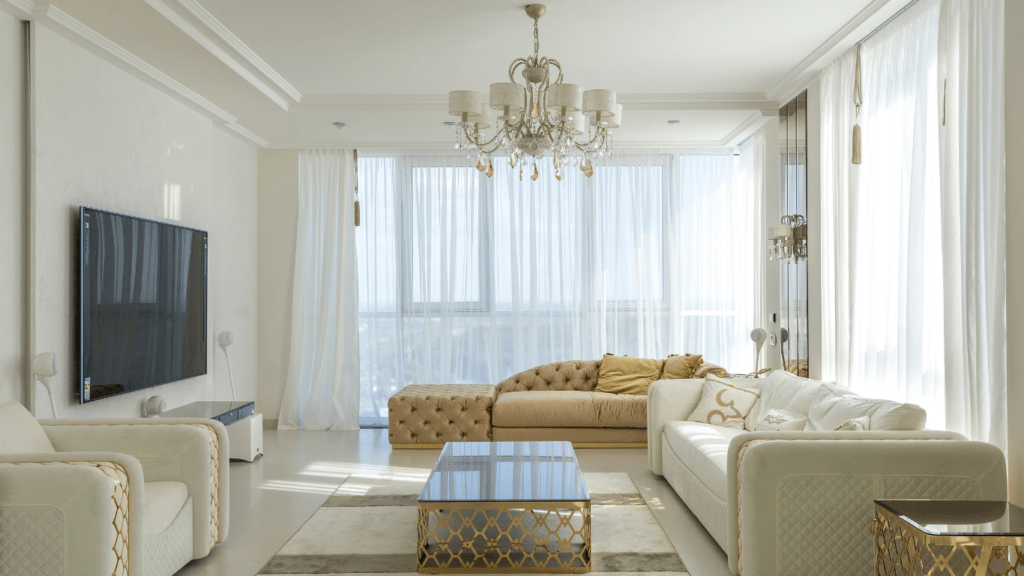Understanding Awkward Spaces
Awkward spaces can turn into design challenges but offer unique opportunities for creativity. Recognizing these areas helps plan more effectively and make the most of available space.
Identifying Problem Areas
Many homes have areas that seem difficult to furnish. These can include narrow hallways, corners in large rooms, and spaces under stairs. Finding these spots helps create an effective layout. Take measurements to know precisely what you’re working with and visualize potential solutions.
Common Types of Awkward Spaces
Several types of awkward spaces frequently arise in home design.
- Long, Narrow Rooms: Hallways and galley kitchens often fall into this category. These spaces usually lack sufficient width for standard furniture arrangements.
- Oddly-Shaped Rooms: Triangular or L-shaped rooms present unique challenges but can be furnished creatively with custom or modular pieces.
- Rooms with Multiple Doorways: Living rooms or foyers with several doors can disrupt the flow and symmetry of furniture layouts.
- Under-Stair Areas: These spaces can be challenging due to varying ceiling heights but can be excellent for storage solutions like built-in cabinetry.
Each type presents unique challenges but, with strategic placement and the right furniture, these can become functional areas.
Planning Your Layout
Effective planning is crucial for arranging furniture in awkward spaces. Accurate measurements and a well-drafted floor plan can transform even the most challenging areas.
Measuring Your Space
Precise measurements form the foundation of a functional layout. Measure the length and width of the room and note any niches or protrusions. Don’t forget to measure doorways, windows, and existing furniture to understand how these elements will interact within the space. Use a tape measure to get accurate dimensions and a notepad to record the measurements.
Creating a Floor Plan
Sketching a floor plan helps visualize the layout. Draw the room’s shape and include all the measured dimensions. Mark the locations of windows, doors, and any fixed elements like radiators or built-in shelves. Online tools and apps can assist in creating a more detailed plan. Try multiple configurations to find the most optimal layout for your furniture.
Choosing the Right Furniture

Selecting the right furniture can transform awkward spaces into functional and stylish areas. Focus on versatility and adaptability when picking pieces for these unique spaces.
Multi-Functional Pieces
Consider furniture that serves multiple purposes. Convertible sofas, for instance, can act as seating by day and a bed by night. Extendable dining tables work well in small dining areas, expanding only when needed. Look for ottomans with storage, allowing you to declutter while providing extra seating. Nested tables fit under each other when not in use, saving space but offering table surfaces when needed.
Appropriate Sizes and Shapes
Measure the available space before choosing furniture. Large, bulky furniture can overwhelm a small or oddly-shaped room. Opt for slim, streamlined pieces to maintain a balanced look. Use modular furniture which fits perfectly in spaces with unusual shapes or multiple doorways. Circular tables work well in rooms with tight corners, aiding movement and flow. Rectangular or L-shaped pieces suit long, narrow rooms, utilizing space effectively without obstructing pathways.
Maximizing Space Efficiency
Maximizing space efficiency involves using every inch of available space in creative ways. This section will explore vertical storage solutions and ways to utilize corners and nooks effectively.
Vertical Storage Solutions
Vertical storage solutions leverage wall space in areas that often get overlooked. Installing tall bookshelves or cabinets can help keep things organized without taking up floor space. Floating shelves provide additional storage for books, decorative items, or kitchen supplies. Wall-mounted racks and pegboards in kitchens and garages create designated spots for utensils, tools, or other essentials. Using vertical storage preserves valuable floor space, making the room feel more spacious.
Utilizing Corners and Nooks
Utilizing corners and nooks transforms underused spots into functional areas. Corner shelves or cabinets can display decorative items or store household necessities. L-shaped desks fit well into corners, creating efficient workspaces. Placing a bench with storage beneath a window can create a cozy reading nook with added storage for books or blankets. These strategies reclaim unused areas, effectively increasing the room’s overall usability.
Visual Tricks for Better Flow
Awkward spaces present unique opportunities to use visual tricks for better flow. Simple changes can enhance the appearance and functionality of any room.
Using Mirrors and Lighting
Mirrors and lighting can significantly improve a room’s flow. Mirrors create the illusion of depth and make small spaces appear larger by reflecting light. Large mirrors or mirrored furniture can be strategically placed to open up tight areas. For example, a floor-length mirror opposite a window can enhance natural light, making the room feel more expansive.
Lighting also plays a crucial role. Layered lighting, such as:
- combining overhead lights
- floor lamps
- wall sconces
can illuminate different areas, reducing shadows and highlighting key features. Using dimmers allows for adjustable lighting, creating a dynamic flow and the right mood for various activities.
Color and Texture Tips
Colors and textures can enhance the sense of space and flow in awkward areas. Light, neutral colors on walls and larger pieces of furniture can make a room feel open and airy. For instance, shades of white, beige, or light gray can recede into the background, reducing the sense of clutter.
Textures add depth and interest. Combining different materials, like a soft rug with a sleek metal coffee table, creates a balanced look. Soft fabrics, smooth surfaces, and reflective materials can contribute to a harmonious flow without overwhelming the space. Using similar tones across different textures can also enhance cohesion in the room’s design.
Room-Specific Strategies
Arranging furniture in an awkward space requires tailored approaches for different rooms. Here are some strategies to optimize layouts in various living areas.
Living Room Arrangements
Focus on creating clear pathways in the living room. Position larger pieces like sofas against the wall to maximize space. Use a slim console table behind the sofa for extra storage. Incorporate multifunctional furniture, such as ottomans that double as storage, to reduce clutter. For oddly shaped rooms, arrange seating in a U or L shape to encourage conversation and maintain flow.
Bedroom Solutions
Keep bedrooms cozy and functional by choosing furniture that fits well. Opt for a bed with built-in storage underneath. Use wall-mounted shelves to free up floor space. In narrow rooms, place the bed against the longest wall and keep bulky furniture to a minimum. Consider a fold-out desk or a mounted bedside table to save space.
Kitchen and Dining Room Tips
In compact kitchens, use vertical storage for utensils and cookware. Install shelves or pegboards on the walls to keep counters clear. For dining areas, choose a round table to maximize seating in tight spaces. Extendable dining tables can provide flexibility for gatherings. Position the dining table near a window or open space to create a feeling of openness.
Home Office Setups
Create a productive home office by maximizing efficiency. Use compact desks that fit into alcoves or corners. Wall-mounted desks or floating shelves save space and keep the area organized. Incorporate storage solutions like filing cabinets or vertical organizers to keep supplies out of sight. For limited space, a fold-down desk can be an excellent choice. Ensure the office has ample lighting, ideally natural light, to reduce eye strain.
By applying these room-specific strategies, one can turn awkward spaces into functional, stylish areas.



 Betsylie Sheetsin – Home Renovation Expert
Betsylie Sheetsin serves as the Home Renovation Expert at Castle Shelf House, specializing in giving practical advice for both small and large-scale home improvements. With years of experience in construction and renovation, Betsylie understands the importance of blending durability with design. Her insights into home renovation projects, along with expert advice on the latest materials and techniques, empower homeowners to tackle even the most ambitious projects confidently.
Betsylie Sheetsin – Home Renovation Expert
Betsylie Sheetsin serves as the Home Renovation Expert at Castle Shelf House, specializing in giving practical advice for both small and large-scale home improvements. With years of experience in construction and renovation, Betsylie understands the importance of blending durability with design. Her insights into home renovation projects, along with expert advice on the latest materials and techniques, empower homeowners to tackle even the most ambitious projects confidently.
